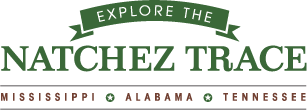Peoples’ choice.
Majestic mounds and other significant sites make the Natchez Trace Parkway a
popular destination for a soul-stirring history of native peoples.
Americans love Native American history—they enjoy reading about it, writing about it, watching it on the screen. But there’s no substitute for real experience, and that’s why the Natchez Trace Parkway has become a favored destination for those who wish to understand and appreciate Native American history at a deeper level.
While the Parkway bears the name of the tribe who traveled it as a hunting route for centuries, the Natchez weren’t the only tribe or even the first to travel the Trace. According to Natchez Trace Supervisory Interpretive Park Ranger David Carney, three historic Indian tribes—the Natchez, the Choctaw and the Chickasaw—populated the area after the recorded era began.
However, those tribes were descended from even earlier people groups. In fact, the Parkway’s Native American history stretches as far back as 12,000 years in Mississippi. As archeologists sift through the evidence, studying the Parkway’s ancient sites, “we’re still discovering things,” Carney says.
Visitors enjoy making their own discoveries on the Parkway as they survey Native American history, starting at the top. Native American roots take on fascinating height all along the Natchez Trace Parkway in burial and domiciliary mounds, including:
- Emerald Mound—Built by the Natchez Indians between AD 1250 and 1600, this ceremonial mound, located in Natchez, is the second largest of its type in the nation, stretching skyward 35 feet. The entire site encompasses eight acres, with a trail leading to the top.
- Boyd Mounds—These smaller mounds were built between the Late Woodland and Early Mississippian periods, sometime between AD 800 and 1100. While there are six mounds on the site, only Mound 2 is accessible to visitors.
- Bynum Mounds—Located thirty miles north of Ridgeland, these mounds were built during the Middle Woodland period, sometime between 100 BC and AD 100.
- Pharr Mounds—Located halfway between Tupelo and the Shoals area, this 90-acre complex of eight different burial mounds was built during the Middle Woodland period between AD 1 and 200.
- Bear Creek Mound—Built between AD 1200 and 1400, this mound is located about 20 miles north of the Pharr Mounds.
- Florence Mound—A domiciliary mound built during the Woodland Period, this mound is the largest of its kind in the Tennessee Valley. An adjacent museum features artifacts from the region dating back 10,000 years.
For many visitors, the many overlapping layers of history inspire a deep and varied sense of wonder. “People climb to the top of Emerald Mound, and they can’t believe that anything could approach the grandeur,” Carney says. “But then others are struck by the sheer number of mounds at Pharr.”
The Mounds aren’t the only significant sites on the Parkway. Others include:
- The Grand Village of the Natchez Indians—A sun worshipping people with rigid class distinctions, the Natchez were the largest and most unified tribe in the region until 1729, when the French, allied with the Choctaw, drove the tribe from the region. While some Natchez were amalgamated into the Creek, Cherokee and Chickasaw tribes, others were captured by the French and sold into slavery. Today at the Grand Village of the Natchez Indians, a National Historic Landmark located in the city of Natchez, visitors can explore the partially restored mound area, a museum accredited by the American Association of Museums, a reconstructed Natchez Indian house, nature trails and a picnic pavilion.
- The Chickasaw Village—Exhibits at this site describe that tribe’s history and daily life, with a nature trail blooming with plants used by the early tribe. A few miles away, the Chickasaw Council House is located on the site of Pontatok, the capital of the Chickasaw Nation in 1820.
- Natchez Trace Parkway Visitors Center—Located in Tupelo, the Visitors Center offers interactive exhibits that broaden understanding of early history, while an adjacent hiking trail leads to the Chickasaw Village.
With an evolving portrait provided by on-going archeological cataloguing, the Parkway staff keeps an open dialogue with Native American groups to insure the greatest possible inclusiveness and accuracy. For example, Stennis Young, Assistant Superintendent of the Parkway, says that in the production of the interactive exhibits featured in the Tupelo Visitors Center, local Native American groups were given an integral role in the effort.
“They reviewed everything. It was a real collaborative process.”
Of course, true collaboration with native peoples has not always prevailed in American history. At Milepost 128.4, a marker denotes the site where the great chief Pushmataha and Andrew Jackson, among others, signed the Treaty of Doak’s Stand in 1820, ceding 5.5 million acres of Choctaw lands to the United States. Pushmataha later went to Washington to protest the terms of the treaty; he spent two years of his life there until he was felled by a fatal case of croup. He was buried in Washington, but such was his renown that his funeral cortege stretched for a mile. More than two thousand mourners, common people and dignitaries alike—including the chief’s old adversary in negotiations, President Andrew Jackson—turned out to pay their respects in a ceremony that included a booming cannon salute.
There are no sounds of the cannon at the Doak’s Stand milepost, or at the top of Emerald Mound, or on the nature trail of the Chickasaw Village, but for visitors to the Natchez Trace Parkway, the echoes of rich history and a vibrant people are unmistakable and inviting.
FOR VISITOR INFORMATION: 866-TRACE 56
(866-872-2356)
www.scenictrace.com
